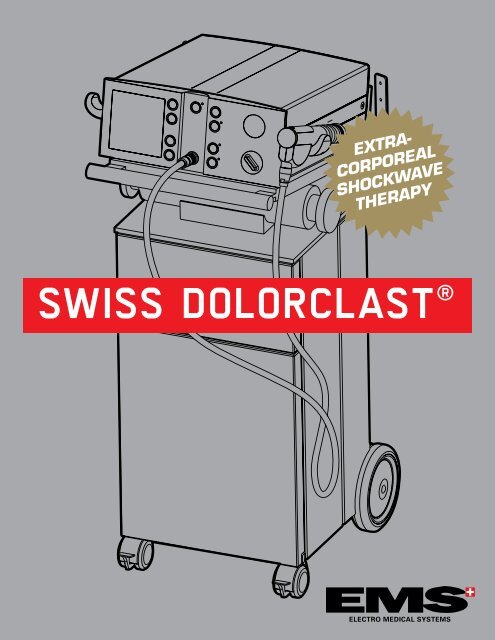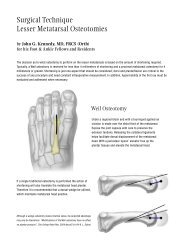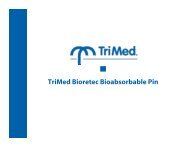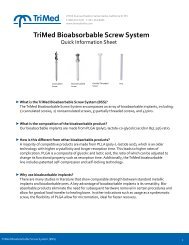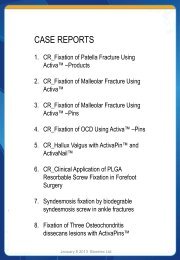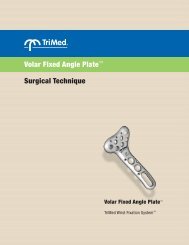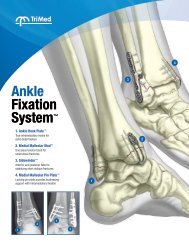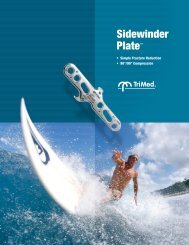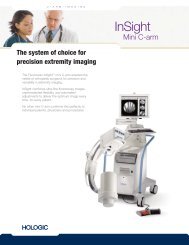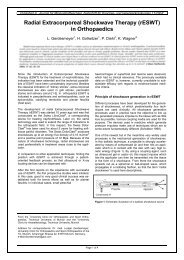Swiss DolorClast ® Brochure - Ortho Providers
Swiss DolorClast ® Brochure - Ortho Providers
Swiss DolorClast ® Brochure - Ortho Providers
Create successful ePaper yourself
Turn your PDF publications into a flip-book with our unique Google optimized e-Paper software.
EXTRA-<br />
CORPOREAL<br />
SHOCKWAVE<br />
THERAPY
<strong>Swiss</strong> <strong>DolorClast</strong> ® - FDA Class III Approved.
<strong>Swiss</strong> <strong>DolorClast</strong> ® - FDA Class III Approved.
Substance P plays a central role as a pain-mediator and growth factor.<br />
> Shockwaves lead to depletion of substance P out of its storing vesicles.<br />
> This molecular mechanism explains the long lasting analgesic effect of shockwaves.<br />
Furthermore, substance P has been shown to dilate blood vessels, stimulate neovascularization<br />
and contribute to new bone formation.<br />
<br />
> Shock waves stimulate the early expression of angiogenesis related growth factors including<br />
eNOS (endothelial nitric oxide synthase), VEGF (vessel endothelial growth factor) and PCNA<br />
(proliferating cell nuclear antigen). This promotes neovascularisation that improves blood supply<br />
and increases cell proliferation and tissue regeneration to repair tendon or bone tissues.<br />
<br />
> Scientific studies show that shockwaves, and the overstimulating of small nerve fibers, block an<br />
increase in pain stimuli and thus intensify the analgesic effect (Melzak and Wall, Gate Control Theory).<br />
<br />
<br />
<br />
Scientific Background<br />
1. Hausdorf J, Schmitz C, Averbeck B, Maier M. - Molecular basis for pain mediating properties of extracorporeal shock waves<br />
Schmerz. 2004 Dec;18(6):492-7. German.<br />
2. Maier M, Averbeck B, Milz S, Refior HJ, Schmitz C. - Substance P and prostaglandin E2 release after shock wave application to the rabbit femur.<br />
Clin <strong>Ortho</strong>p Relat Res. 2003 Jan;(406):237-45.<br />
3. Wang CJ. - An overview of shock wave therapy in musculoskeletal disorders.<br />
Chang Gung Med J. 2003 Apr;26(4):220-32. Review.
Substance P plays a central role as a pain-mediator and growth factor.<br />
> Shockwaves lead to depletion of substance P out of its storing vesicles.<br />
> This molecular mechanism explains the long lasting analgesic effect of shockwaves.<br />
Furthermore, substance P has been shown to dilate blood vessels, stimulate neovascularization<br />
and contribute to new bone formation.<br />
<br />
> Shock waves stimulate the early expression of angiogenesis related growth factors including<br />
eNOS (endothelial nitric oxide synthase), VEGF (vessel endothelial growth factor) and PCNA<br />
(proliferating cell nuclear antigen). This promotes neovascularisation that improves blood supply<br />
and increases cell proliferation and tissue regeneration to repair tendon or bone tissues.<br />
<br />
> Scientific studies show that shockwaves, and the overstimulating of small nerve fibers, block an<br />
increase in pain stimuli and thus intensify the analgesic effect (Melzak and Wall, Gate Control Theory).<br />
<br />
<br />
<br />
Scientific Background<br />
1. Hausdorf J, Schmitz C, Averbeck B, Maier M. - Molecular basis for pain mediating properties of extracorporeal shock waves<br />
Schmerz. 2004 Dec;18(6):492-7. German.<br />
2. Maier M, Averbeck B, Milz S, Refior HJ, Schmitz C. - Substance P and prostaglandin E2 release after shock wave application to the rabbit femur.<br />
Clin <strong>Ortho</strong>p Relat Res. 2003 Jan;(406):237-45.<br />
3. Wang CJ. - An overview of shock wave therapy in musculoskeletal disorders.<br />
Chang Gung Med J. 2003 Apr;26(4):220-32. Review.
Kinetic energy is converted into impact energy,<br />
as illustrated by Newton’s Cradle.
The advantage of extracorporeal shockwaves is that<br />
they produce an analgesic effect on the treated area.<br />
The unfocused propagation of the shockwaves extends<br />
to the entire area where pain occurs.
The advantage of extracorporeal shockwaves is that<br />
they produce an analgesic effect on the treated area.<br />
The unfocused propagation of the shockwaves extends<br />
to the entire area where pain occurs.
1. Locating the area of pain by palpation 2. Marking the treatment area<br />
3. Applying the contact gel 4. Delivering the shockwaves
1. Locating the area of pain by palpation 2. Marking the treatment area<br />
3. Applying the contact gel 4. Delivering the shockwaves
Heel pain is a “catch-all term” for any condition that can occur around the heel. The most common<br />
of these conditions is known as PLANTAR FASCIITIS. The plantar fascia (PF) is a strong ligament (tensile<br />
strength of 4000 lbs/sq. inch) that is located along the under surface of the foot, extending from the base of<br />
the toes to the heel bone (calcaneus). The PF is almost as wide as the foot and plays an important role in<br />
support of the foot as well as function.<br />
> When the plantar fascia is strained due to overuse, improper shoes, or abnormal foot structure, it can<br />
initially become irritated and painful. As we get older, tissues become less flexible and the PF can become<br />
strained from something as simple as walking a full day in Disneyworld with non supporting, flat shoes.<br />
Although most people have heel pain that lasts only a couple of days, many have repeated episodes of PF<br />
strain leading to the development of scar tissue in the plantar fascia. It is thought that this scar tissue is the<br />
cause of chronic heel pain also known as plantar fasciosis. Although heel spurs (a small forward projection<br />
of bone under the heel) are related to plantar fasciitis, research has shown that permanent elimination of<br />
heel pain caused by plantar fascioses does NOT require the removal of the heel spur.<br />
> Plantar fasciitis is diagnosed with the classic symptoms of pain well localized over the heel area of the<br />
bottom of the foot. Often the pain from plantar fasciitis is most severe when you first stand on your feet in<br />
the morning. Pain often subsides quite quickly, but then returns after prolonged standing or walking.<br />
<br />
> Plantar fasciitis is most often seen in middle-aged men and women, but can be found in all age<br />
groups. The condition can be seen in people with high arches, normal arches, and flatfeet. Activities that<br />
seem to initiate PF are people who change their heel height on shoes from normal to flat heels; walking or<br />
running on a soft surface with non supporting shoes; taking on an exercise program and doing too much,<br />
too fast, and standing for long periods of time on a hard surface.<br />
> Plantar fasciitis is sometimes, but not always, associated with overweight people. It is sometimes seen<br />
in recreational athletes, especially runners. In these athletes, it is thought that the repetitive nature of the<br />
sport causes damage to the tissue at the attachment of the PF to the heel.<br />
> Symptoms of plantar fasciitis are typically worsened early in the morning after sleep. At that time, the<br />
arch tissue is tight and simple movements stretch the contracted tissue. As you begin to loosen the foot, the<br />
pain usually subsides, but often returns with prolonged standing or walking.
“<br />
The Weil Foot & Ankle Institute has been involved with Extracorporeal<br />
Shockwave Therapy (ESWT) since 2000 and was the first group in the USA<br />
to publish the results of this treatment for plantar fasciosis. Since that time,<br />
I have been the principal investigator on three FDA studies using different<br />
ESWT technologies (electrohydraulic, piezoelectric, and pneumatic technology<br />
– <strong>Swiss</strong> <strong>DolorClast</strong> ® ). Much to our surprise, the double blinded results of the <strong>Swiss</strong><br />
<strong>DolorClast</strong> ® superseded the results of the other two technologies while offering<br />
a tolerable treatment, over three sessions, without the use of sedation or even local anesthetic.<br />
We believe that ESWT with the <strong>Swiss</strong> <strong>DolorClast</strong> ® will be an important addition to treatment<br />
of the podiatric, orthopaedic, and sports medicine patients. ”<br />
<br />
“<br />
We had excellent experiences with the <strong>Swiss</strong> <strong>DolorClast</strong> ® , and I can fully recommend it. It is a<br />
valuable part of a modern treatment concept. Through(out) our international network, we have treated<br />
many professional athletes, and in no time they were all back in the game thanks to this non-invasive and<br />
gentle treatment.<br />
The medical community has only just begun to discover the possibilities of this treatment. ”<br />
<br />
<br />
“<br />
The Institute of Biomechanics and <strong>Ortho</strong>paedics of the German Sport<br />
University Cologne has been working with Extracorporeal Shockwaves Therapy<br />
(ESWT) for several years, with respect to clinical applications as well as basic<br />
research concerning its effects on a cellular level.<br />
During my personal experience with the <strong>Swiss</strong> <strong>DolorClast</strong> ® as the attending<br />
medical professional of ATP tennis players, I have observed an increased relevance<br />
of this therapy in the field of sports medicine and in the care of professional athletes.<br />
Based on our clinical application and various experimental research projects, extracorporeal<br />
shockwaves seem to be a successful and simple form of therapy for orthopaedic disorders. ”
“<br />
The <strong>Ortho</strong>Trauma Clinic has investigated safety and effectiveness of<br />
repetitive low-energy shock wave treatment without local anaesthesia for patients<br />
with chronic plantar fasciopathy (plantar heel pain).<br />
ESWT with the <strong>Swiss</strong> <strong>DolorClast</strong> ® device was effective in about 60%<br />
of cases. No rupture of the plantar fascia occurred, no side effects with the<br />
exception of bruising were recorded.<br />
Extracorporeal Shockwave Therapy (ESWT) is an important addition to<br />
treatment options for patients with recalcitrant plantar fasciopathy. ”<br />
<br />
<br />
“<br />
Heel pain can become a “chronic disease” which has a negative effect on a<br />
patient’s quality of life. Since the results of surgery are not guaranteed, extracorporeal<br />
shockwave therapy with the <strong>Swiss</strong> <strong>DolorClast</strong> ® provides an attractive alternative for<br />
the treatment of chronic heel pain syndrome. I am impressed by the high success rate<br />
and lack of complications in our study patients. ”<br />
<br />
“<br />
<strong>Swiss</strong> <strong>DolorClast</strong> ® is our permanent companion on ATP’s tennis tournaments and has become<br />
increasingly popular with players. ”<br />
<br />
<br />
<br />
“<br />
For plantar fasciitis the dolorclast system is incredibly convenient for doctor<br />
and patient. No need for anesthesia. “On the spot” in office delivery of therapeutic<br />
shockwaves. Safe, effective and well tolerated.<br />
Everyone should have one! ”
“<br />
The <strong>Ortho</strong>Trauma Clinic has investigated safety and effectiveness of<br />
repetitive low-energy shock wave treatment without local anaesthesia for patients<br />
with chronic plantar fasciopathy (plantar heel pain).<br />
ESWT with the <strong>Swiss</strong> <strong>DolorClast</strong> ® device was effective in about 60%<br />
of cases. No rupture of the plantar fascia occurred, no side effects with the<br />
exception of bruising were recorded.<br />
Extracorporeal Shockwave Therapy (ESWT) is an important addition to<br />
treatment options for patients with recalcitrant plantar fasciopathy. ”<br />
<br />
<br />
“<br />
Heel pain can become a “chronic disease” which has a negative effect on a<br />
patient’s quality of life. Since the results of surgery are not guaranteed, extracorporeal<br />
shockwave therapy with the <strong>Swiss</strong> <strong>DolorClast</strong> ® provides an attractive alternative for<br />
the treatment of chronic heel pain syndrome. I am impressed by the high success rate<br />
and lack of complications in our study patients. ”<br />
<br />
“<br />
<strong>Swiss</strong> <strong>DolorClast</strong> ® is our permanent companion on ATP’s tennis tournaments and has become<br />
increasingly popular with players. ”<br />
<br />
<br />
<br />
“<br />
For plantar fasciitis the dolorclast system is incredibly convenient for doctor<br />
and patient. No need for anesthesia. “On the spot” in office delivery of therapeutic<br />
shockwaves. Safe, effective and well tolerated.<br />
Everyone should have one! ”
“<br />
The <strong>Ortho</strong>Trauma Clinic has investigated safety and effectiveness of<br />
repetitive low-energy shock wave treatment without local anaesthesia for patients<br />
with chronic plantar fasciopathy (plantar heel pain).<br />
ESWT with the <strong>Swiss</strong> <strong>DolorClast</strong> ® device was effective in about 60%<br />
of cases. No rupture of the plantar fascia occurred, no side effects with the<br />
exception of bruising were recorded.<br />
Extracorporeal Shockwave Therapy (ESWT) is an important addition to<br />
treatment options for patients with recalcitrant plantar fasciopathy. ”<br />
<br />
<br />
“<br />
Heel pain can become a “chronic disease” which has a negative effect on a<br />
patient’s quality of life. Since the results of surgery are not guaranteed, extracorporeal<br />
shockwave therapy with the <strong>Swiss</strong> <strong>DolorClast</strong> ® provides an attractive alternative for<br />
the treatment of chronic heel pain syndrome. I am impressed by the high success rate<br />
and lack of complications in our study patients. ”<br />
<br />
“<br />
<strong>Swiss</strong> <strong>DolorClast</strong> ® is our permanent companion on ATP’s tennis tournaments and has become<br />
increasingly popular with players. ”<br />
<br />
<br />
<br />
“<br />
For plantar fasciitis the dolorclast system is incredibly convenient for doctor<br />
and patient. No need for anesthesia. “On the spot” in office delivery of therapeutic<br />
shockwaves. Safe, effective and well tolerated.<br />
Everyone should have one! ”
“<br />
The <strong>Ortho</strong>Trauma Clinic has investigated safety and effectiveness of<br />
repetitive low-energy shock wave treatment without local anaesthesia for patients<br />
with chronic plantar fasciopathy (plantar heel pain).<br />
ESWT with the <strong>Swiss</strong> <strong>DolorClast</strong> ® device was effective in about 60%<br />
of cases. No rupture of the plantar fascia occurred, no side effects with the<br />
exception of bruising were recorded.<br />
Extracorporeal Shockwave Therapy (ESWT) is an important addition to<br />
treatment options for patients with recalcitrant plantar fasciopathy. ”<br />
<br />
<br />
“<br />
Heel pain can become a “chronic disease” which has a negative effect on a<br />
patient’s quality of life. Since the results of surgery are not guaranteed, extracorporeal<br />
shockwave therapy with the <strong>Swiss</strong> <strong>DolorClast</strong> ® provides an attractive alternative for<br />
the treatment of chronic heel pain syndrome. I am impressed by the high success rate<br />
and lack of complications in our study patients. ”<br />
<br />
“<br />
<strong>Swiss</strong> <strong>DolorClast</strong> ® is our permanent companion on ATP’s tennis tournaments and has become<br />
increasingly popular with players. ”<br />
<br />
<br />
<br />
“<br />
For plantar fasciitis the dolorclast system is incredibly convenient for doctor<br />
and patient. No need for anesthesia. “On the spot” in office delivery of therapeutic<br />
shockwaves. Safe, effective and well tolerated.<br />
Everyone should have one! ”
“<br />
The <strong>Ortho</strong>Trauma Clinic has investigated safety and effectiveness of<br />
repetitive low-energy shock wave treatment without local anaesthesia for patients<br />
with chronic plantar fasciopathy (plantar heel pain).<br />
ESWT with the <strong>Swiss</strong> <strong>DolorClast</strong> ® device was effective in about 60%<br />
of cases. No rupture of the plantar fascia occurred, no side effects with the<br />
exception of bruising were recorded.<br />
Extracorporeal Shockwave Therapy (ESWT) is an important addition to<br />
treatment options for patients with recalcitrant plantar fasciopathy. ”<br />
<br />
<br />
“<br />
Heel pain can become a “chronic disease” which has a negative effect on a<br />
patient’s quality of life. Since the results of surgery are not guaranteed, extracorporeal<br />
shockwave therapy with the <strong>Swiss</strong> <strong>DolorClast</strong> ® provides an attractive alternative for<br />
the treatment of chronic heel pain syndrome. I am impressed by the high success rate<br />
and lack of complications in our study patients. ”<br />
<br />
“<br />
<strong>Swiss</strong> <strong>DolorClast</strong> ® is our permanent companion on ATP’s tennis tournaments and has become<br />
increasingly popular with players. ”<br />
<br />
<br />
<br />
“<br />
For plantar fasciitis the dolorclast system is incredibly convenient for doctor<br />
and patient. No need for anesthesia. “On the spot” in office delivery of therapeutic<br />
shockwaves. Safe, effective and well tolerated.<br />
Everyone should have one! ”
“<br />
The <strong>Ortho</strong>Trauma Clinic has investigated safety and effectiveness of<br />
repetitive low-energy shock wave treatment without local anaesthesia for patients<br />
with chronic plantar fasciopathy (plantar heel pain).<br />
ESWT with the <strong>Swiss</strong> <strong>DolorClast</strong> ® device was effective in about 60%<br />
of cases. No rupture of the plantar fascia occurred, no side effects with the<br />
exception of bruising were recorded.<br />
Extracorporeal Shockwave Therapy (ESWT) is an important addition to<br />
treatment options for patients with recalcitrant plantar fasciopathy. ”<br />
<br />
<br />
“<br />
Heel pain can become a “chronic disease” which has a negative effect on a<br />
patient’s quality of life. Since the results of surgery are not guaranteed, extracorporeal<br />
shockwave therapy with the <strong>Swiss</strong> <strong>DolorClast</strong> ® provides an attractive alternative for<br />
the treatment of chronic heel pain syndrome. I am impressed by the high success rate<br />
and lack of complications in our study patients. ”<br />
<br />
“<br />
<strong>Swiss</strong> <strong>DolorClast</strong> ® is our permanent companion on ATP’s tennis tournaments and has become<br />
increasingly popular with players. ”<br />
<br />
<br />
<br />
“<br />
For plantar fasciitis the dolorclast system is incredibly convenient for doctor<br />
and patient. No need for anesthesia. “On the spot” in office delivery of therapeutic<br />
shockwaves. Safe, effective and well tolerated.<br />
Everyone should have one! ”
*<br />
<br />
<br />
<br />
<br />
<br />
<br />
> The number of potential patients is very high.<br />
> Anyone who suffers from chronic heel pain may be treated with the <strong>Swiss</strong> <strong>DolorClast</strong> ® method.<br />
> It is a proven alternative to surgery.<br />
> It offers a new and promising alternative to patients who are surgery candidates or are resigned to<br />
their condition and no longer seek therapy.<br />
> Today, many more patients are able to afford Extracorporeal Shockwave Therapy because compared<br />
to other methods the <strong>Swiss</strong> <strong>DolorClast</strong> ® method is much more economical.<br />
<br />
Patients per month<br />
x<br />
Applications per patient<br />
<br />
Total applications<br />
x<br />
Charge per application<br />
<br />
Monthly revenue
Display desired impulse count per treatment<br />
Display current impulse count<br />
Display operating frequency<br />
Increase impulse count per treatment<br />
Reduce impulse count per treatment<br />
<br />
<br />
<br />
<br />
<br />
<br />
<br />
<br />
<br />
<br />
<br />
<br />
<br />
<br />
<br />
<br />
<br />
Increase operating frequency<br />
Reduce operating frequency<br />
On/Off with indicator light<br />
Handpiece connection<br />
“Select” to activate change in preset impulse count<br />
“Validate” to confirm setting<br />
Single-impulse operation<br />
Continuous impulse operation<br />
Manometer for operating pressure<br />
<br />
Operating pressure regulator<br />
Handpiece<br />
Cable holder<br />
Bottle holder (gel)<br />
Drawer<br />
Compressor compartment
Electro Medical Systems (EMS) has been setting standards in the development and production of medical<br />
devices since 1981. Each product is individually produced and tested in Switzerland – with <strong>Swiss</strong> precision.<br />
> EMS is one of the world’s leading manufacturers of prophylactic dental devices.<br />
> With over 8,000 <strong>Swiss</strong> LithoClast ® devices in daily use, EMS is the world’s largest supplier<br />
of intracorporeal shockwave lithotriptors for the treatment of kidney, ureteric and bladder stones.<br />
> With its patented <strong>Swiss</strong> <strong>DolorClast</strong> ® , EMS offers products that benefit from the expertise and EMS<br />
offers a product defined experience with pneumatically generated shockwaves. Since its market introduction<br />
in 1999, <strong>Swiss</strong> <strong>DolorClast</strong> ® has been the reference for successful pain therapy and has made EMS the number<br />
one in Shockwave Therapy.<br />
> Like all EMS products, <strong>Swiss</strong> <strong>DolorClast</strong> ® meets the highest European and international<br />
quality standards.<br />
> Product certification: FDA Class III Medical Device, ISO 9001, ISO 13485 (Medical Devices),<br />
and CE Mark.<br />
> EMS is a promoting member of the ISMST (International Society for Musculoskeletal Shockwave<br />
Therapy), an official member of DIGEST (German and International Society for Extracorporeal Shockwave<br />
Therapy) and supports ATRAD (Association for Radial Pain Therapy).
CAUTION! Federal law restricts this device to sale by or on the order of a physician.


